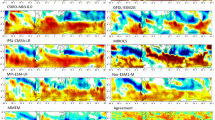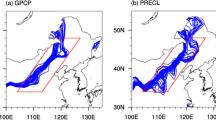Abstract
Wintertime fronts climatology and the relationship between fronts and precipitation as depicted by a group of CMIP5 models are evaluated over the Southern Hemisphere (SH). The frontal activity is represented by an index that takes into account the vorticity, the gradient of temperature and the specific humidity at the 850 hPa level. ERA-Interim reanalysis and GPCP datasets are used to assess the performance of the models in the present climate. Overall, it is found that the models can reproduce adequately the main features of frontal activity and front frequency over the SH. The total precipitation is overestimated in most of the models, especially the maximum values over the mid latitudes. This overestimation could be related to the high values of precipitation frequency that are identified in some of the models evaluated. The relationship between fronts and precipitation has also been evaluated in terms of both frequency of frontal precipitation and percentage of precipitation due to fronts. In general terms, the models overestimate the proportion between frontal and total precipitation. In contrast with frequency of total precipitation, the frequency of frontal precipitation is well reproduced by the models, with the higher values located at the mid latitudes. The results suggest that models represent very well the dynamic forcing (fronts) and the frequency of frontal precipitation, though the amount of precipitation due to fronts is overestimated.







Similar content being viewed by others
References
Berry G, Reeder MJ, Jakob C (2011) A global climatology of atmospheric fronts. Geophys Res Lett 38:L04809. doi:10.1029/2010GL046451
Bjerknes J, Solberg H (1922) Life cycle of cyclones and the polar front theory of atmospheric circulation. Geophys Publ 3:1–18
Blázquez J, Solman SA (2016) Intraseasonal variability of wintertime frontal activity and its relationship with precipitation anomalies in the vicinity of South America. Clim Dyn 46:2327–2336. doi:10.1007/s00382-015-2704-0
Blázquez J, Solman SA (2017) Interannual variability of the frontal activity in the Southern Hemisphere: relationship with atmospheric circulation and precipitation over southern South America. Clim Dyn 48:2569–2579. doi:10.1007/s00382-016-3223-3.
Browning KA, Roberts NM (1994) Structure of a frontal cyclone. Q J R Meteorol Soc 120:1535–1557. doi:10.1002/qj.49712052006
Catto JL, Jakob C, Berry G, Nicholls N (2012) Relating global precipitation to atmospheric fronts. Geophys Res Lett 39:L10805. doi:10.1029/2012GL051736
Catto JL, Nicholls N, Jakob C, Shelton KL (2014) Atmospheric fronts in current and future climates. Geophys Res Lett 41:7642–7650. doi:10.1002/2014GL061943
Catto JL, Jakob C, Nicholls N (2015) Can the CMIP5 models represent winter frontal precipitation? Geophys Res Lett 42:8596–8604. doi:10.1002/2015GL066015
Chang EKM, Guo Y, Xia X, Zheng M (2013) Storm-track activity in IPCC AR4/CMIP3 model simulations. J Clim 26:246–260. doi:10.1175/JCLI-D-11-00707.1
Dai A (2006) Precipitation characteristics in eighteen coupled climate models. J Clim 19:4605–4630. doi:10.1175/JCLI3884.1
Dee DP et al (2011) The ERA-interim reanalysis: configuration and performance of the data assimilation system. Q J R Meteorol Soc 137:553–597. doi:10.1002/qj.828
Flato G, Marotzke J, Abiodun B, Braconnot P, Chou SC, Collins W, Cox P, Driouech F, Emori S, Eyring V, Forest C, Gleckler P, Guilyardi E, Jakob C, Kattsov V, Reason C, Rummukainen M (2013) Evaluation of climate models. In: Stocker TF, Qin D, Plattner G-K, Tignor M, Allen SK, Boschung J, Nauels A, Xia Y, Bex V, Midgley PM (eds) Climate change 2013: the physical science basis. Contribution of working group I to the fifth assessment report of the intergovernmental panel on climate change. Cambridge University Press, Cambridge
Forster PM, Andrews T, Good P, Gregory JM, Jackson LS, Zelinka M (2013) Evaluating adjusted forcing and model spread for historical and future scenarios in the CMIP5 generation of climate models. J Geophys Res: Atmos 118(3):1139–1150. doi:10.1002/jgrd.50174
Garreaud R, Vuille M, Compagnucci R, Marengo J (2009) Present-day South American climate. PALAEO 281(3):180–195. doi:10.1016/j.paleo.2007.10.032
Grainger S, Frederiksen CS (2014) Assessment of modes of interannual variability of southern hemisphere atmospheric circulation in CMIP5 models. J Clim 27:8107–8125. doi:10.1175/JCLI-D-14-00251.1
Grieger J, Leckebusch GC, Donat MG, Schuster M, Ulbrich U (2014) Southern Hemisphere winter cyclone activity under recent and future climate conditions in multi-model AOGCM simulations. Int J Climatol 34:3400–3416. doi:10.1002/joc.3917
Gulizia C, Camilloni I (2015) Comparative analysis of the ability of a set of CMIP3 and CMIP5 global climate models to represent precipitation in South America. Int J Climatol 35:583–595. doi:10.1002/joc.4005
Herold N, Alexander LV, Donat MG, Contractor S, Becker A (2016) How much does it rain overland? Geophys Res Lett 43:341–348. doi:10.1002/2015GL066615
Hewson TD (1998) Objective fronts. Meteorol Appl 5:37–65. doi:10.1017/S1350482798000553
Houze RA (2014) Cloud dynamics, 2nd edn. Academic Press, Oxford
Huffman GJ, Adler RF, Morrissey M, Bolvin DT, Curtis S, Joyce R, McGavock B, Susskind J (2001) Global precipitation at one-degree daily resolution from multi-satellite observations. J Hydrometeorol 2:36–50.doi:10.1175/1525-7541(2001)002<0036:GPAODD>2.0.CO;2
IPCC (2013) Climate change 2013: the physical science basis. Contribution of working group I to the fifth assessment report of the intergovernmental panel on climate change. Cambridge University Press, Cambridge
Koutroulis AG, Grillakis MG, Tsanis IK, Papadimitriou L (2016) Evaluation of precipitation and temperature simulation performance of the CMIP3 and CMIP5 historical experiments. Clim Dyn 47:1881–1898. doi:10.1007/s00382-015-2938-x
Mehran A, AghaKouchak A, Phillips TJ (2014) Evaluation of CMIP5 continental precipitation simulations relative to satellite-based gauge-adjusted observations. J Geophys Res Atmos 119:1695–1707. doi:10.1002/2013JD021152
Pendergrass A, Hartmann DL (2014) Two modes of change of the distribution of rain. J Clim 27:8357–8371. doi:10.1175/JCLI-D-14-00182.1
Simmonds I, Keay K, Bye JAT (2012) Identification and climatology of Southern Hemisphere mobile fronts in a modern reanalysis. J Clim 25:1945–1962. doi:10.1175/JCLI-D-11-00100.1
Simmons A, Uppala S, Dee D, Kobayashi S (2007) ERA-interim: new ECMWF reanalysis products from 1989 onwards. ECMWF Newsl 110:25–35
Sinclair M R (1995) A climatology of cyclogenesis for the Southern Hemisphere. Mon Weather Rev 123:1601–1619. doi:10.1175/1520-0493(1995)123<1601:ACOCFT>2.0.CO;2
Solman SA, Orlanski I (2010) Subpolar high anomaly preconditioning precipitation over South America. J Atmos Sci 67:1526–1542. doi:10.1175/2009JAS3309.1
Solman SA, Orlanski I (2014) Poleward shift and change of frontal activity in the Southern Hemisphere over the last 40 years. J Atmos Sci 71:539–552. doi:10.1175/JAS-D-13-0105.1
Solman SA, Orlanski I (2016) Climate change over the extratropical Southern Hemisphere: the tale from an ensemble of reanalysis datasets. J Clim 29:1673–1687. doi:10.1175/JCLI-D-15-0588.1
Sun Y, Solomon S, Dai A, Portmann RW (2006) How often does it rain? J Clim 19:916–934. doi:10.1175/JCLI3672.1
Taylor KE, Stouffer RJ, Meehl GA (2012) An Overview of CMIP5 and the experiment design. Bull Am Meteorol Soc 93:485–498. doi:10.1175/BAMS-D-11-00094.1
Acknowledgements
We acknowledge the World Climate Research Programme’s Working Group on Coupled Modelling, which is responsible for CMIP, and we thank the climate modeling groups (listed in Table 1 of this paper) for producing and making available their model output. For CMIP the US Department of Energy’s Program for Climate Model Diagnosis and Intercomparison provides coordinating support and led development of software infrastructure in partnership with the Global Organization for Earth System Science Portals. This work was supported by the following grants: FONCyT-PICT-2012-1972, FONCyT-PICT-2014-2730 and UBACYT2014 No. 20020130200233BA. We wish to thank the anonymous reviewers whose comments allowed substantial improvements to the manuscript.
Author information
Authors and Affiliations
Corresponding author
Rights and permissions
About this article
Cite this article
Blázquez, J., Solman, S.A. Fronts and precipitation in CMIP5 models for the austral winter of the Southern Hemisphere. Clim Dyn 50, 2705–2717 (2018). https://doi.org/10.1007/s00382-017-3765-z
Received:
Accepted:
Published:
Issue Date:
DOI: https://doi.org/10.1007/s00382-017-3765-z




